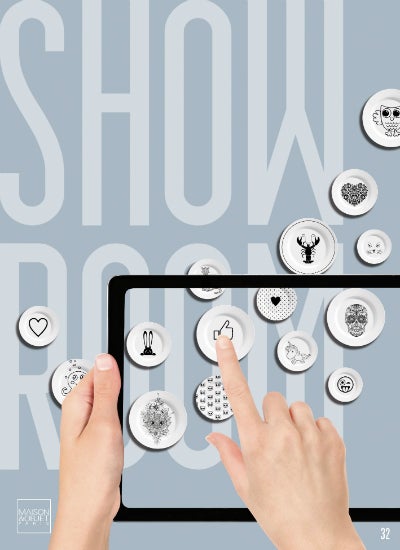
In January, Agence NellyRodi will be designing the Inspirations Space and the Bookshop-Café on the concept SHOWROOM.
Since September 2016, the three Trend Consultants of the MAISON&OBJET Observatory have taken turns designing the Inspirations Forum to bring the edition’s concept to life, sharing their own personal vision of the collective work carried out all year round.
This latest concept emerged as the product of the investigative work conducted by NellyRodi’s team of consultants on a variety of societal, industry, and marketing topics. The concept will also be further discussed in light of the broader context of lifestyle trends at L’Espace Conférences.
Editor-in-chief Marie-Jo Malait said: "In our digital times, a whole world of lifestyles is just a click away. Social networks do the spadework, clearing the ground leaving only objects of desire as the well-honed online consumer becomes the artistic director and designer of his/her interior.
"Homemakers indulge in a form of decorative exhibitionism and with transparency in every shape, size and form showcase their significant objects in display cases or on shelves. Walls show off these new collectors’ juxtaposed accumulation of pictures, or their modern-day take on decorative plates; still lifes are arranged as if posing to have their photo taken, ready to be posted on Instagram; and light transforms volumes in a dramatic and theatrical approach to interiors that brings a touch of magic back into everyday life. Click to say you "like" it and make sure to share."
Below are five questions asked to designer and scenographer of the Inspirations Forum and Bookshop-Café for January 2018 – MAISON&OBJET PARIS, Vincent Grégoire (Agence NellyRodi).
#1 :Why did you choose this concept, Showroom, and how would you define it?
The financial crisis and the digital revolution have had a tremendous impact on our behaviours. Consumers who used to have a passive posture, buying products without questioning the brands that sell them, have found empowerment. Through digital technologies, consumers now have access to product information, can compare prices, and even have the possibility to share comments on the products and rate them.
A new generation of hyper-connected and hyper-informed consumers is reclaiming control: they are establishing their status as an inescapable partner for brands. With the advent of Instagram particularly, consumers are becoming trend-setters themselves, full-fledged influencers. They share their finds with their communities, revealing themselves, or flaunting themselves in some cases, making commitments and voicing opinions.
This is what we have called the showroomisation trend*: it is no longer the product that makes the consumer, but the consumer that makes the product.
#2 : How does it impact consumption patterns and the interior market?
Whenever they share their hauls and stage their latest purchases, consumers play the parts of art directors, designers, architects, merchandisers, visual communication experts or even sales ambassadors: they share advice, promote products, post content on behalf of brands, all from the comfort of their own homes. They become a source of inspiration, validated by other users. The showroom trend is the expression of the growing inclination to publicize one’s life, one’s intimacy, one’s world, to show both the stages people create, as well as what’s behind the scenes. As a result, the old rules no longer apply – story-telling is rendered obsolete by story-living.
Consumers no longer want to be told stories, they want to experience things. So living rooms and retail stores are turned into stages for the whole world to see. But the showroomisation trend can also have the opposite effect on some individuals, causing them to reject all digital technologies altogether, along with the onslaught of images and uberised services that come with them, and to revel in anonymity and secrecy. A sort of digital detox, so to speak.
#3 : What elements are most representative of the Showroom trend?
Exemplifying how showroomisation is impacting our lives and objects, interiors feature an increasing amount of typical showroom elements – racks, glass partitions, shelving units – as well as walk-in wardrobes. Clothes are carefully displayed, tables are artfully set, kitchen appliances sit ostentatiously on countertops. Assuming the role of collectors and curators, we stage the products, style them, present them as works of art, to make them digitally digestible – an essential process for those wishing to make a name for themselves and to assert their identity. This is truly the advent of an ego-based culture.
Beside mirrors, which are popping up everywhere, another good example of this is the fact that many MAISON&OBJET exhibitors are showing a variety of decorative elements featuring representations of human faces, figures and masks, from dining plates to rugs and lamps, bringing the Facebook experience into the home, in a way.
#4 : What scenography have you imagined for the Inspirations Space?
Of course, I wanted the place to have a dramatic feel, with mirrors, glass display cases, spotlights, but I also wanted it to be interactive, to reflect the new dynamic initiated by social networks. To that effect, I have imagined a live experience for visitors, notorious or otherwise. I will tables covered with objects and empty shelves placed around the exhibition and visitors will be asked to make their own selections and to explain their reasons for making such or such choices. It will be a dynamic, interactive, living and, most importantly, casual environment, because there is more to this trend than rigid staging.
#5 : In a few words, what is the message of this exhibition?
The Inspirations Space is an invitation to question the status quo and take a stand, to overcome ennui. It is a chance to set yourself apart, to voice your opinion, to love and hate, just like on social networks. The retail business is in urgent need of re-enchantment. A shop is not merely a place where goods are stored for sale. The advent of digital technologies, for better or worse, is pushing retail businesses to come to life, to make their shops feel more like home. Customers need a place where they can experience products and share their opinions. The point is no longer to please everyone, but to please one’s community.
Because the dynamic has shifted, all notions of good and bad taste have gone out the window. Pieces by iconic design brands are shamelessly associated with cheap trinkets – it is the rule of whim. We tell stories so people can experience these stories. Business needs to reconnect with passion, with emotion, to present customers with unique moments for a chance to surprise and move them. These are wonderful times we are living, where the only constant is change. We just need to realise it.

